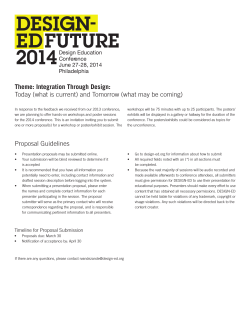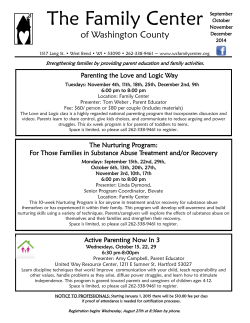
9 A LETTER FROM GRANDMA UNIT UNIT OVERVIEW
UNIT 9 A LETTER FROM GRANDMA UNIT OVERVIEW In this unit, students will: T Read and listen to Rohini talking about her grandmother. Answer true/false questions to show understanding of the story. T Consider three alternative opinions about the best way to communicate and express agreement or disagreement with the opinions. Study the Opinion Network to learn expressions for agreeing with someone’s idea or opinion. Extend the Topic by talking about the best ways to stay in touch. Read a Culture Corner extract about the most common social activities in the 1950s. Share ideas about someone who is important to them. Listen to a follow-up video extract from Andrea giving her views about what it really means to be connected. Take the Unit Test. Authors’ Introduction Go to impactseries.com/issues to listen to Junko’s unit introduction. The Issue In this unit, a young woman talks about a letter from her grandmother that moved her deeply. Rohini, like many other young people, uses a cell phone, sends text messages, has her own web page and blog, and spends a lot of time looking at a computer screen. When she receives and reads a four-page handwritten letter from her grandma, she realizes that maybe her life is moving too fast. She rethinks her lifestyle and ways of communication. This unit is asking the students: Is faster always better? Does being online always mean you are connected? Questions Raised Are our lives moving too fast? What are we missing out on by always being in a hurry? Talking on cell phones, sending text messages, or emailing is easier and faster than writing a letter, but isn’t writing or receiving a letter more personal and more fulfilling? What is the best way for you to stay in touch with people? When do you feel you are “connected”? To Keep in Mind It might be necessary to make students realize that slowing down or living life at a slower pace does not just mean inconvenience or wasting your time. You might need to give examples such as local trains vs. express trains. What is wonderful about local trains? What can you experience that you cannot on express trains? There may be students who feel faster is always better. They may not be able to imagine any other ways besides using the Internet and cell phones to be connected with other people. They may say they are perfectly happy like that. 38 TEACHING GUIDE Getting Ready Have students work in pairs. Ask them to figure out who has the busier lifestyle or if they are about the same. Teaching tip: Before moving on to the Situation, you could ask for a quick show of hands for those who think they have a busy lifestyle and those who don’t (#1). For those who say “yes” you can follow up by getting a few examples of what makes them busy (#2). Finally, ask for volunteers to answer #3. Situation Consider having students go over the four questions in Check Your Understanding (page 43) before listening to the recording. Have them make guesses. Then have them listen to the recording and read the Situation at the same time. As a class, see how many they were able to guess correctly. m Teaching tip: Have students shadow Rohini. Play the CD and have students read the text aloud along with it, their voice following like a shadow of the recorded voice. Have students do the same thing this time without looking at the text, just following the audio. Check Your Understanding Answer Key 1. T 2. F 3. F 4. T What Do You Think? After you check students’ understanding of the story using the comprehension questions, students discuss their opinions of Susan, Luis, and Ken. Discussion should be done in pairs. Have students do Activity A individually. Then have them move to Activity B and share their opinions in pairs. m Teaching tip: Make sure students fully understand each opinion before they decide to agree or disagree. You could ask which two people share the same general opinion (Susan and Luis) and which person doesn’t (Ken). 2 Culture Point: To follow up on Luis’s opinion, you could ask your students a few questions about how face-to-face communication is valued in their culture. For example: When is it appropriate or expected to have face-to-face communication IN your culture? Is there any time when you avoid it? In your culture, when do you feel you are most connected? Extending the Topic: Staying in touch Have students work individually when giving their ratings for ways to communicate and reasons for why they feel this way, and in pairs (or threes) for the follow-up discussion. Give students plenty of time to fill out the chart. Be sure that they add their own idea at the bottom. The more they think about their preferences, the easier it will be for them to do the following discussion activity. You could wrap up the activity by asking one person in each group to give the group’s preferred ways of communicating. Culture Corner Have students work in pairs or groups of three. Students read through the list of top social activities from the 1950s. Give them an opportunity to ask about unknown words. As this list is clearly based on Western culture, you could ask them to imagine what the top activities were in their own culture. Are they same or different? 39 Sharing My Ideas: Someone important to me Choose Begin by having the students answer the question “Who is an important person to you?” Explain that they are going to tell a story about the person they have chosen. Prepare and Rehearse Your students can use the Thinking notes and Language Hints to prepare for their presentation. Then they practice telling the story to a partner without looking at what they have written. For this step, students can exchange notes so that their partners can help them if they are having a hard time remembering what they have written. The Presentation is about going slowly and not rushing. People who are not comfortable speaking in front of groups tend to speed through their presentations. Be sure to go over the tip before students rehearse. This will give them a chance to work on their pace before presenting in Step 4. Sample Presentation I’d like to talk about a special person. Her name is Ms. Tao. She was my junior high school teacher. She is a very caring and devoted teacher. I was being bullied and could not go to school for some time. Ms. Tao came to my house many times and talked with me for a long time. She then went to see the students who were bullying me and talked with them many times. I did not think those students would change. But Ms. Tao did not give up. Finally they changed their attitude and the bullying stopped. I really respect Ms. Tao. When I think about her, I always feel grateful for what she did for me. Present Have students find a new partner, or put them into small groups. Go over the Listener task as a whole class. Be sure students understand that they will write a question to ask the speaker at the end of the presentation. The Presentation Tip says, “Wait for your audience to respond.” So the speaker may not say, “Any questions?” Therefore, the listeners may have to take initiative and ask their question without being prompted. If you are using the assessment guide below, go over each point with the whole class before students begin their presentations. (This could also be done during the Rehearse step so that students have time to prepare for or practice each assessment point.) Be sure to remind your students that communicating their ideas is more important than using perfect English! Assessing the Activity Have students evaluate the presenter. Create a handout showing a checklist such as the one below, or write it on the board: 1 – The presenter used a “warm” opening. Y N 2 – The presenter used a personal closing. Y N 3 – The presenter did not rush through the presentation. Y N 4 – The presenter was easy to understand. Y N 5 – At the end, the presenter waited for the audience to respond. Y N When students are working in pairs, have each student evaluate the other. If a student presents in front of the class, have each student grade him or her. PERSONAL OPINION If you have downloaded the video clip or have access to the Internet in class, play the video clip. The first time, have the students watch with books closed. Ask questions to see if the students have understood the gist of Andrea’s opinion. Then have them look at the summary. See if they can fill in the missing words. Play the extract once or twice more. Then check the answers. 40 Answer Key And rea Things like text messaging and emailing are kind of natural for us because they take next to no time at all. But if you think about it, it’s those letters and those cards that actually do take time that mean the most. For example, last year, believe it or not, I got my first postcard in my life from a friend. I had been emailing her regularly while she was gone, but the emails didn’t mean that much. It was the postcard I received that really made me feel like I was finally in touch with her again. It was so personal. And it was so “her.” It felt like she cared about me, and that’s what meant the most. From this experience, I’m able to relate to the young woman in the story who received the letter from her grandmother. Her grandmother sat down, just like my friend did, and wrote to her. And that’s what meant the most. And that’s what kind of got her back in touch with her grandmother and made her feel that connection. UNIT TEST Make copies of the Unit Test for each student. Distribute the copies and allow about 15 minutes for the class to complete the Test. Correct the Test in class. A. Und erst and in g t he S itu at io n: The focus is on understanding how Rohini felt after receiving and reading the letter from her grandmother. B. V o cabu lary: The focus is on understanding three words or phrases from the Situation or the Extending the Topic sections. Students fill in three missing words of a short paragraph that summarizes the Situation. C. Exp ress ions : The focus is on you check students’ understanding of words or phrases from the What Do You Think? section. Students answer two multiple-choice questions. Answer Key A. 1. c 2. b 3. c 4. b 5. d B. handwritten, fast, communicate C. 1. c 2. b LINKS If you would like the class to do additional research on rethinking lifestyles, here are some useful links: Slow down, you move too fast: http://search.japantimes.co.jp/cgi-bin/fl20000329td.html Anja’s Slow Mother Diary: http://anjaslowmotherdiary.blogspot.com/2008/03/slohas-slow-lifestyles-of-health-and.html Search What Japan Thinks: http://whatjapanthinks.com/tag/lifestyle/ 41
© Copyright 2025





















